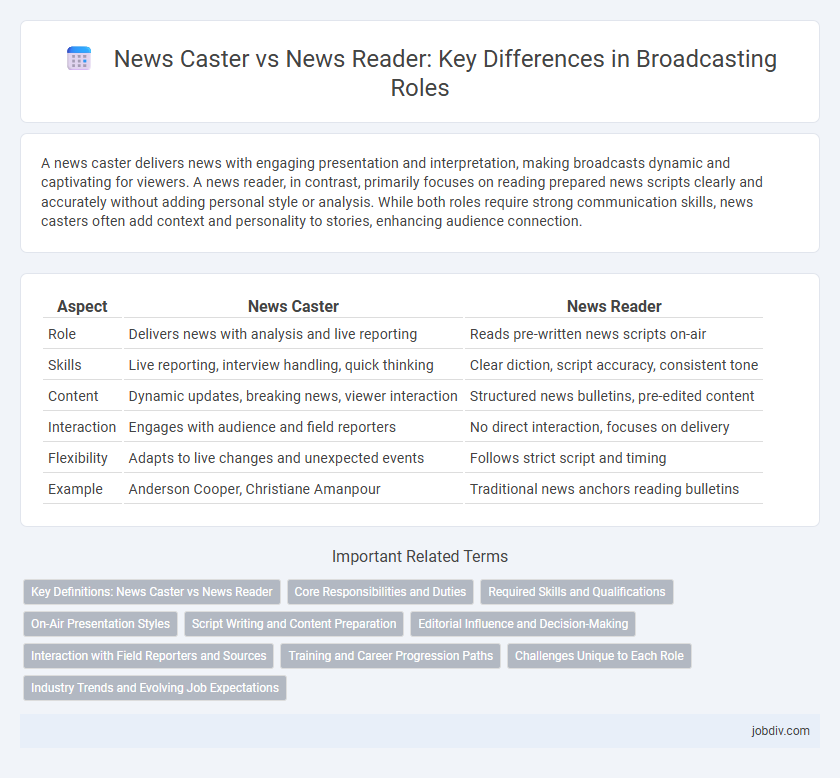A news caster delivers news with engaging presentation and interpretation, making broadcasts dynamic and captivating for viewers. A news reader, in contrast, primarily focuses on reading prepared news scripts clearly and accurately without adding personal style or analysis. While both roles require strong communication skills, news casters often add context and personality to stories, enhancing audience connection.
Table of Comparison
| Aspect | News Caster | News Reader |
|---|---|---|
| Role | Delivers news with analysis and live reporting | Reads pre-written news scripts on-air |
| Skills | Live reporting, interview handling, quick thinking | Clear diction, script accuracy, consistent tone |
| Content | Dynamic updates, breaking news, viewer interaction | Structured news bulletins, pre-edited content |
| Interaction | Engages with audience and field reporters | No direct interaction, focuses on delivery |
| Flexibility | Adapts to live changes and unexpected events | Follows strict script and timing |
| Example | Anderson Cooper, Christiane Amanpour | Traditional news anchors reading bulletins |
Key Definitions: News Caster vs News Reader
A news caster is a broadcast journalist who actively presents news stories with commentary, analysis, and personal engagement, often shaping the narrative for viewers. A news reader primarily focuses on delivering scripted news content verbatim without adding personal interpretation or opinion. The distinction lies in the news caster's interpretative role versus the news reader's straightforward recitation of information.
Core Responsibilities and Duties
News casters deliver live news with a polished presentation, adding interpretation and analysis to engage viewers. News readers focus primarily on reading scripted news bulletins clearly and accurately without providing commentary. Both roles require strong communication skills, but news casters often take on additional responsibilities like conducting interviews and interacting with the audience.
Required Skills and Qualifications
News casters require strong public speaking abilities, excellent improvisation skills, and in-depth knowledge of current events to deliver live broadcasts confidently. News readers must possess clear diction, strong memorization skills, and the ability to interpret scripts accurately to maintain audience engagement. Both roles demand proficiency in using broadcasting equipment, adherence to journalistic ethics, and often a degree in journalism or communications.
On-Air Presentation Styles
News casters employ dynamic storytelling techniques and engage viewers with expressive body language, creating a compelling on-air presence that adds depth to the news. News readers maintain a more neutral and formal delivery, focusing on clear articulation and factual accuracy without personal interpretation. The distinction in presentation styles directly impacts audience perception, with news casters often seen as relatable and news readers as authoritative sources.
Script Writing and Content Preparation
News casters play an active role in script writing and content preparation, often collaborating with editors to tailor the news for live delivery. News readers primarily focus on delivering pre-written scripts verbatim, with limited involvement in content creation. Effective broadcasting benefits from news casters' input in shaping the narrative, ensuring clarity and engagement for the audience.
Editorial Influence and Decision-Making
News casters actively shape the narrative with editorial influence, often making real-time decisions on story emphasis and tone, while news readers primarily deliver scripted content with limited input on editorial choices. The news caster's role involves interpreting and prioritizing information to engage the audience, whereas the news reader's responsibility centers on clear and accurate presentation. Editorial control in broadcasting typically rests with the news caster, who balances journalistic integrity and audience appeal in decision-making processes.
Interaction with Field Reporters and Sources
News casters engage dynamically with field reporters and sources, conducting live interviews and asking real-time questions to clarify unfolding events, enhancing audience understanding. News readers primarily relay pre-prepared scripts with limited direct interaction, focusing on clear and accurate delivery of gathered information. Effective collaboration between casters and reporters ensures timely, coherent news coverage that bridges the studio and field reporting.
Training and Career Progression Paths
News casters undergo extensive training in voice modulation, on-camera presence, and live reporting to develop dynamic storytelling skills, often advancing to anchor prime-time broadcasts or editorial roles. News readers typically receive focused instruction on script accuracy, pronunciation, and teleprompter proficiency, progressing into specialized presenting or voice-over careers within broadcast journalism. Career growth for news casters emphasizes versatility and field experience, whereas news readers often build expertise in anchoring scripted segments and studio-based presentations.
Challenges Unique to Each Role
News casters face challenges in live reporting that demand quick thinking, strong on-camera presence, and the ability to adapt to breaking news in real time. News readers must maintain accuracy and clarity while delivering pre-written scripts, ensuring seamless pronunciation and tone consistency under tight time constraints. Both roles require mastering technical equipment and managing viewer engagement, but casters handle spontaneous content whereas readers focus on precise script delivery.
Industry Trends and Evolving Job Expectations
News casters are increasingly expected to deliver live reports with dynamic storytelling skills, while news readers focus on clear, accurate script reading. Industry trends highlight a shift toward multi-platform presence, requiring both roles to engage audiences across TV, digital, and social media. The evolving job expectations emphasize adaptability, advanced communication abilities, and a deeper understanding of journalistic ethics and audience engagement metrics.
News Caster vs News Reader Infographic

 jobdiv.com
jobdiv.com